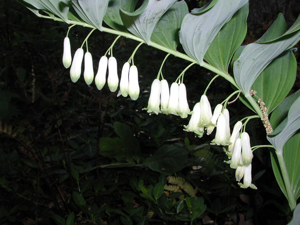Resource Library
Plant of the Week: Solomon's Seal, Giant
The University of Arkansas System Division of Agriculture does not promote, support or recommend plants featured in "Plant of the Week." Please consult your local Extension office for plants suitable for your region.
Plant of the Week
Giant Solomon’s Seal
Latin: P. biflorum var. commutatum.

Patience is a virtue, especially in gardening. Amongst my favorite plants in my shade garden are several species of Solomon’s Seals in the genus Polygonatum. The Solomon’s Seals are all herbaceous rhizomatous perennials that can form large, bold colonies but your patience will be sorely tested as you await their spread.
About 50 species of Solomon’s Seals are described in the botanical literature with species found in North America, Europe and Asia. These plants are former members of the giant lily family but are now classified as belonging to the asparagus family. In the United States Polygonatum biflorum is the most common with it found in almost all of the states east of the Rockies. In such a wide geographic range and a multitude of habitats, the species varies considerably and botanists have often given divergent forms their own Latin names. The Giant Solomon’s Seal I purchased as Polygonatum giganteum is now correctly referred to as P. biflorum var. commutatum.
Giant Solomon’s Seal is said to grow to 7 feet tall but for me it has yet to exceed 4 feet in height. It has a single unbranched arching stem that arises from the rhizome in mid spring. Its 5-inch long sessile leaves are arranged alternately up the stem and are held upright like bat wings on the up stroke of flight. The upper leaf surface is a bright shiny green with the undersurface a glaucous gray.
When the stem is fully extended flowers begin appearing below the arching stems on inch long dangling peduncles. The peduncles terminate in two paired flowers on less vigorous stems but on more vigorous plants, six or more individual blooms may be produced on each peduncle. The fleshy flowers are inch long white tubes tipped with a green band of six petals. Were I a jewelry designer, I would use the drooping peduncles of Solomon’s Seal as a model for ear rings. In late summer, the flowers are followed by plump, pea-sized blue-black berries.
I also grow a locally collected strain of Solomon’s Seal that, though the botanists assure me is in the same genus, appears quite different from Giant Solomon’s Seal. The local strain blooms about three weeks later, it has a 2-inch long peduncle, the flowers are not fleshy and the leaves are not as thick and luxuriant. Both are fine plants but the giant form has more garden worthy characteristics.
Solomon’s Seal is given this common name because the stem scar is said to resemble the official Seal of King Solomon. The Greek name used for the European species during the time of Dioscorides (40-90 AD) was Sigillium Solomonis. The association of the plant with King Solomon does indeed seem to be an ancient one. Gerard, in his 1630 herbal, used the name Polygonatum latifolium for the same species, beating Linnaeus to the punch by over a century.
I have found all of the five species of Solomon’s Seals I grow to be slow to establish, but once settled in they are almost indestructible in the garden. Once the establishment stage is past – for me taking at least five years - the colonies tend to increase fairly rapidly with the size of the stand radiating outward like a restrained bamboo.
Propagation is easy by division of the clump or by seed. Growing plants from seed is slow with two years required to break seed dormancy and then two to three years more required to grow plants large enough to transplant into the garden. Division of Solomon’s Seal rhizomes should be done in late winter before plants begin to grow. I divided a dense stand of Polygonatum odoratum ‘Variegatum’ – a truly musical sounding name – and ended up with a bunch of rhizomes that did not have an actively growing bud. These rhizomes were potted but during the following summer nothing emerged. I was slow to dump the pots and was surprised the following spring – a full year after potting – to find the “blind” rhizomes had sprouted and quickly formed attractive plants.
Solomon’s Seals are ideal for shaded, woodland gardens where they can be allowed to grow undisturbed. They are best in fertile, reasonably moist locations in soils with an acidic pH.
By: Gerald Klingaman, retired
Retired Extension Horticulturist - Ornamentals
Extension News - April 13, 2012
The University of Arkansas System Division of Agriculture does not maintain lists of retail outlets where these plants can be purchased. Please check your local nursery or other retail outlets to ask about the availability of these plants for your growing area.